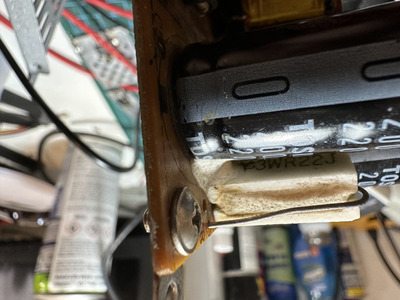Well, now you need to decide if you want to continue or not - because this will not be an easy case and it very well might turn out to be a lost cause (for example a short in the transformer) which is very frustrating (and so can be the investigation into cause quite frankly, although that is at least a learning experience).
First, the basics and safety rules again: Always wait for the primary capacitors to discharge before working on PSU that was connected to mains (limiting bulb or not). Do not change the fuse for higher rated one. In fact, if anything, for 230V operation a 3A slow-blow fuse should be enough, the 5A one is for 115V. That being said this PSU has poor input surge protection so perhaps 5A fuse is required, otherwise it would eventually blow on its own sometime during power-on. But that's why it should be a slow-blow fuse and not a fast one.
If you don't want to keep changing the fuse then add another one (with a proper holder) into the power cord, just like you added the current limiting lightbulb. This at the very least will be easier to access and replace, and you can even use a household type resetable breaker (but it should be something low rated, lower than 5A in PSU anyway, like 3-4 amps which usually is not available for typical panel fuse holders).
With that being said, if you want to continue (for now anyway): remove PCB from case, inspect both it and case for any burn and soot marks. You find anything like that, investigate. Although a short to case would trip your house breakers before the fuse - at least that is how it's supposed to work. But check anyway, including these mounting standoffs for any possible shorting.
Since you run the PSU with no transistors but capacitors in place, and the bulb went dark, we know it's not the input caps. So check the diodes again, this new overcurrent event could have killed another one again, but other then diodes it leaves you with the transistors, their driving circuits, and the transformer. Transistors could be faulty, not shorted completly but not turning off at higher CE voltages (breakdown voltage degraded in other words). Although this could also be a fault witht he driving circuitry, past the smaller impulse transformer.
Look at the schematic here: http://www.pavouk.org/hw/en_atxps.html
It's complicated but you are only concerned with the driving part now, so upper middle section. There's two identical/symmetric driving circuits: C9, D3, R6-R8 / C10, D4, R10-R12. You need to find these parts (obviously the numbering and exact circuit will not be a 100% match) on your PSU. Of these driving circuits the diode and capacitor must be checked. Even replaced (especially the capacitor) if in doubt. Also R8 and R12 must be in-spec and not too high value. If the driving part check out then the transistors should be replaced with another known good (or new) pair. These might have developed problems that only dynamic, high-voltage testing will find, so replacement is easier.
EDIT: Forgot to add: The snubber parts D1, D2 and R4+C8 should also be checked.
Keep in mind this might still not be it, or if the main transformer is shorted internally (winding to winding short would kinda work, like what you have, but pull way too much current) it's a lost cause unless you can replace it. And for that you need a working donor, then why not just use the working donor intead. To properly diagnose that PSU you need a scope, and let me be clear about this: DO NOT CONNECT SCOPE TO PRIMARY SIDE OF MAINS POWERED PSU unless you know what you are doing. It's not safe for the scope, it's not safe for you, unless you happend to have HV differential probes and know how to use them. That's why I said you might have to decide to throw in the towel, at some point it just might not be safe or economic to continue unless you already have prior experience.

